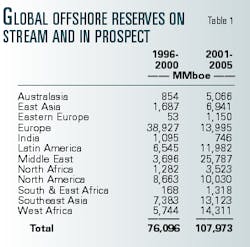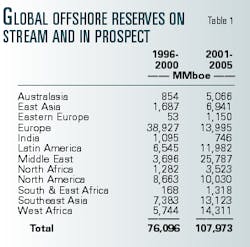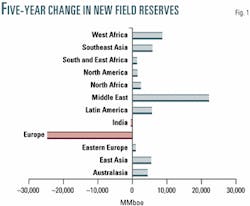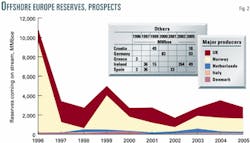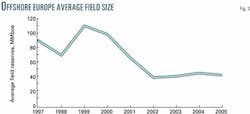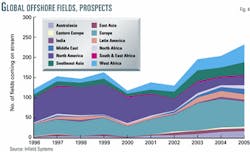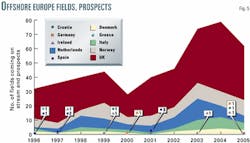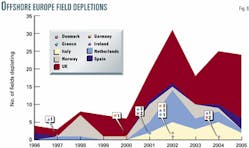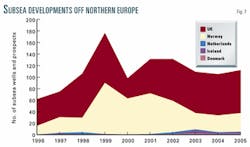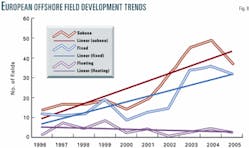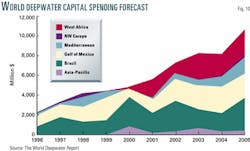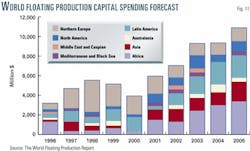The Infield Systems database shows that, in summer 2001, there were 2,918 offshore fields in production worldwide.
North America is the most prolific region with 1,548-about 50% of the world's offshore fields. Europe, by comparison has a "mere" 467.
But when the average field reserves are examined, Northwest Europe shows its importance as a province. The average North American offshore field has reserves of 39 million boe; off Northwest Europe, fields are more than five times that size-an average of 234 million boe.
These numbers are to a great extent a statement of past activity and the relative maturity of the Gulf of Mexico compared with the North Sea. But what of the future? In the past 5 years, Europe has been responsible for 51% of all the offshore oil and gas reserves brought on stream worldwide. But when we look at development prospects under consideration by oil companies for the next 5 years, Europe's share falls to 13%.
The reasons for this is that Offshore Europe is now joining the shallow-water Gulf of Mexico as a mature province, as evidenced by the reserve sizes of new field prospects falling towards the average experienced in the gulf. The result is that the major operators are voting with their feet and investing outside Europe in new, usually deepwater, areas of the world. However, the upside of this situation is that a considerable number of opportunities will remain for players that are geared to the efficient production of small fields.
Whereas operational expenditures off Europe are likely to continue to rise for some years to come, capital expenditures are set for a dramatic decline, bringing with it some tough choices for many local suppliers.
It should be noted that many of the numbers given in this article for future years refer to prospects; unless stated otherwise, they are not forecasts.
The authors undertook a similar analysis of Offshore Europe's prospects in a global context in last year's Offshore Northern Europe report (OGJ, Aug. 14, 2000, p. 84).
Global reserves, prospects
As Table 1 shows, over the 5 years to 2000, new offshore oil and gas reserves totaling some 76 billion boe came on stream worldwide. The largest share was in European waters, much of which was associated with the start-up of Norway's huge Troll gas field. Looking ahead to prospects for 2001-05, these total some 107 billion boe and are dominated by the phased start-up of South Pars field off Iran. The first phase of this giant development is expected to hold some 5.8 billion boe and come on stream in 2002, with further phases during 2004-09.
As stated earlier, this table is not a forecast, as we do not expect all the fields indicated to be bought on stream in the particular years for which they are slated. How ever, it does indicate the considerable prospects for the offshore industry in general and the major changes ahead for Offshore Europe in particular.
In total, over the past 5 years, Europe has been responsible for 51% of all offshore reserves bought on stream worldwide. In terms of currently identified prospects for the period 2001-05, Europe's share falls to 13%. As Fig. 1 shows, the change over the period is dramatic, as Europe's offshore reserve additions decline, and it moves from being the world's leading offshore province to being an "also-ran," one of five similar-sized provinces, all eclipsed by the Middle East.
Moving on to the future situation, Fig. 2 shows that the UK and Norway will continue to dominate new field development prospects. But for the region as a whole, Fig. 3 shows that the overall trend of reserves coming on stream is decidedly downwards, with dramatic reductions in the average size of fields for most European countries. For example, the Norwegian average field size over the past 4 years has been 227 MMboe; for the next 5 years, it is 118 MMboe. But as Table 2 shows, Norway has been a star performer in terms of field size, and this is likely to continue in the immediate future as the UK average field size falls to 37 MMboe from 67 MMboe. (A counter-argument put by some is that the very high costs of Norwegian operations mean that only large fields could be economically developed.)
Perhaps the most interesting aspects of Fig. 3 are the enhanced prospects for some of the smaller producing countries, with significant increases for Ireland, Italy, and the Netherlands. Ireland, due to the start-up of the Corrib North field, increases its annual average field size to 63 MMboe from 10 MMboe. Further prospects are the Seven Heads and Galley Head fields, each of which are gas developments with long subsea tiebacks to shore as the preferred development option.
While a large number of small gas field additions in the UK southern North Sea are expected to supplement UK supply over the next 5 years or so, in Ireland, gas imports are expected to increase shortly with the construction of a second trunk line from the UK.
The Netherlands and Italy face a similar situation with a series of small-scale gas developments being needed to supplement the gradual decline in supplies from existing fields. Both are predominantly gas sectors. However, the F02 Hanze field development in the Dutch sector will go a long way to replacing declining liquids volumes in the Netherlands.
The Italians have no large-scale offshore projects planned to compare with Agip SPA's activities in the Bouri and NC-41C areas off Libya, which will begin to feed large volumes of gas to the Italian domestic market within the period to 2005. The largest home-based project in the Adriatic Sea is the Alto Adriatico, a complex series of 19 platforms on 15 fields in the northern Adriatic just south and east of Venice that may require more than 400 km of large and small-diameter pipelines to fully develop. However, its exact timing is in doubt because of environmental fears that the withdrawal of about 1 tcf of gas from reservoirs so close to the Venetian shore may lead to the subsidence of the city itself. An alternative scheme to import LNG is therefore under consideration.
Continuing exploration in the Dutch sector of the North Sea has brought forward a number of potential fields for development in the near future not only in the classic K and L quadrants, but also in the more marginal P and A and B quadrants. Here, Clyde Petroleum Exploratie BV (formerly owned by Gulf Canada Resources Ltd., now by Conoco Inc.) and Nederlandse Aardolie Maatschappij (NAM) are planning to install reusable platforms that can be moved rapidly from small accumulation to small accumulation to keep up production volumes. In fact, the Dutch are becoming so bullish about their production prospects that they are planning a new gas export line to the UK if it is needed.
Likewise, the Danes are discovering more gas than they believed that they had before. Corrosion problems in Gorm field has led to a reduction in current production rates, but in the future, the increasing development of Halfdan field and the possible development of the Cecilie and Nini finds should make the Danish sector more self-sufficient for longer than previously predicted and also generate a surplus of gas for export. Two schemes are currently under study. One to the east, to supply gas to Poland, is in an advanced stage of planning; one to the west, to connect to the UK gas pipeline system, is in its very early stages of evaluation.
The number of new offshore fields coming on stream each year is charted in Fig. 4, and this shows two major trends: the strong decline in North America (mainly Gulf of Mexico)-a total of 377 fields entering production in 1996-2000 falls to 167 in 2001-05; while those in Europe increase to 313 from 187.
Considering the global situation, North America is the only region in the world where the prospects are apparently reducing-all others show a major increase. Again, this would seem to be a statement about the maturity of the Gulf of Mexico and the move to maturity of the North Sea. However, we expect the total number of developments in the Gulf of Mexico in reality to be higher than this because of the pace of exploration drilling in this area and the fact that a number of expired leases are being taken up again and fresh discoveries being made upon them. This blossoming of second-phase developments is often very fast-track, and therefore it is very difficult to predict the exact number of projects to 5 years ahead.
Likewise, this trend may start to affect the UK Continental Shelf. For instance, there are the licenses around the UK's first oil field, Argyll, which produced about 72 million bbl before shutting down in 1992 but is still believed to hold about 180 million bbl in place-four times the average size of future predicted UK fields and therefore well worth another look.
Looking ahead, the future pattern for new fields off Europe seems similar to that seen in the past, with the UK likely to account for the largest number of yet undeveloped discoveries-some 179 prospects over the next 5 years, with the Netherlands and Norway each having 46. But as shown earlier, these UK finds are very small, with reserves averaging only 37 MMboe.
However, this does highlight the importance to operators of trying to maximize recovery from their existing assets. For instance, a 1% improvement in recovery from total in-place resources in a field such as Forties would in fact exceed the average reserve figure for a future field development. Also, an average figure can mask one or two quite significant discoveries among a plethora of small ones. In the UK sector, this applies to the recent discovery of Buzzard field on Block 20/06-a find rumored to be 200-300 million bbl.
Depleting fields
At the same time as these new fields are being bought on stream, others will be reaching their theoretical end-of-life. Over the past 5 years, 30 fields were depleted off Europe, an average of 6/year. Over the next 5 years, there are prospects for 127 to cease production, for an average of over 25/year. The UK leads the pack with a theoretical 64 fields reaching depletion, compared with 16 in the previous 5-year period. We say "theoretical," as in practice the number will be greatly dependent upon oil prices and the prospects of tiebacks of new wells to existing platforms.
Not all platforms will be removed at once. Facilities have been mothballed in other parts of the world awaiting further reuse, but we do expect a steadily increasing stream of removals to take place. Platform reuse has occurred already in the Netherlands, and new designs featuring the ability to be reused at a future date are currently being engineered, for example, NAM's Neptunus project.
This year has seen the successful removal of the steel gravity-base Maureen platform in the UK sector, and next year will see the removal of two concrete gravity-based platforms in the German sector of the Baltic Sea. Off Norway, Froey platform has come to the end of its useful life, and the decommissioning of some of the platforms in the greater Ekofisk area is also under way.
Subsea wells
A major feature of recent years has been the growth in the use of subsea well completions (SSCs). This trend is evident both in European waters and worldwide.
Overall, Europe has the greatest numbers of existing and prospective installations of any region worldwide. Within Europe, the UK has the largest number of subsea well prospects, some 347 compared with Norway's 213. Much of this is due to the UK sector 's high level of existing infrastructure of platforms that can act as hosts for the subsea development of the considerable numbers of small reservoirs that surround them, such as the tieback of Skene to the Beryl infrastructure.
Examination of the trend lines in Figs. 8 and 9 shows that Offshore Europe is very different from the rest of the world in two specific respects. First, in other regions, fewer fields are being developed with platforms, as operators increase their use of SSCs and floating production systems (FPSs). This is mainly due to finds being made in deeper waters-the Gulf of Mexico is but one example. Also, in the UK sector in particular, there are still a great number of prospects available for exploitation using small, low-cost minimum-facilities platforms (typical of those used in the Gulf of Mexico for many years.)
The second difference is in the use of FPSs. Europe shows a declining trend, whereas the trend for the rest of the world is strongly upwards. This is probably due to the fact that, within the harsh environments of Northern Europe and its Atlantic margin, there are few economically viable deepwater prospects within our time frame, so there are fewer opportunities for using floaters.
This situation is illustrated further in Figs. 10 and 11. Unlike the preceding charts, which considered prospects, these are our global forecasts for future FPS and deepwater capital expenditures.
Fig. 10 shows our capital spending forecast for field developments in water depths greater than 500 m and is taken from The World Deepwater Report-2001-2005. In 2001, we expect global deepwater capital spending to total some $5.6 billion and grow to $10.6 billion/year by 2005-a total of $40 billion over the period. The Northwest Europe region, however, accounts for a mere $214 million-mainly deepwater subsea tiebacks to existing fields in the Atlantic Margin.
Our global forecasts are for capital expenditure on floaters of all types to show strong growth, totaling $42 billion over the next 5 years. This is mainly in West Africa, Latin America, and, to a lesser extent, Asia. Although North America has 20% of the forecast market by FPS numbers, it is only 11% by value due to the predominance of low-cost solutions such as spars and mini-TLPs (tension leg platforms). Greatest growth is likely off Africa due to some very large field prospects. Again, only Northern Europe is expected to experience any significant decline.
Offshore Europe prospects
Offshore Europe has always been a very different region from the other producing areas of the world.
The region has also been complicated by the individual nations' very different approaches to the exploitation of their reserves.
For the UK, the dash to generate oil and gas revenues to repair the economic chaos of the 1960s and 1970s led to what some might say was too rapid an exploitation of its reserves-with the result that all the large prospects have been developed, and it is likely that only small fields remain.
Norway, on the other hand, with its small population was able to adopt a more managed approach to its developments and hoard away huge amounts of the proceeds to pay its citizens' future pensions. The result is that there are still some major prospects ahead but outside our time frame-one example being the massive and technically challenging Ormen Lange field. However, one undesirable outcome associated with Norwegian social policy has been the generation of a very high-cost environment with severe implications for would-be equipment exporters.
As a mature province, Offshore Europe now exhibits many of the characteristics shown earlier by the Gulf of Mexico-a great number of tiny, shallow-water pros pects and a deepwater frontier. Europe now faces a very different future associated with these two extremes. In total, there are 313 fields identified by oil companies as development prospects over the period to 2005. The problem is that the great majority of these are very small: by 2002, the average reserves of prospective fields falls to 40 MMboe.
The future therefore belongs to oil and gas companies who can develop cost-effective approaches to development of small reserves. It is unlikely that the majors will wish to be significant players in this new game when they can invest in deepwater fields in other regions offering reserves of 10-30 times this size. A further opportunity arises for small players in taking over the operations of declining fields from the majors; this, of course, is dependent upon settlement of the decommissioning issues.
The other major consideration is the future for the supply and service industries. High levels of expenditure coupled with huge technical challenges have generated some world-class service and supply companies within Europe. However, they are now facing a major long-term problem: the large home market is set to decline as fields deplete and the size of new prospects reduces dramatically. The leading companies have great skills in the growth market sectors such as deepwater and subsea technology and are already global players, but there are also many companies that do not have exportable services. Therefore, in reality, it is unlikely that export activity can fully replace the home market, and a major reorientation of many of the region's suppliers is essential for the majority of its participants to have a long-term future.
At the other extreme, there is the deep frontier. But this one is not merely deeper, it is in the extreme conditions of the Northern Atlantic and Norway's arctic seas. The existing developments in the West of Shetlands area and off northern Norway have indicated the potential in those area, and if the world's other deepwater plays are anything to go by, this area may also hold considerable prospects-but only for the big, the brave, and the strong.
Bibliography
Infield Systems is a database containing details of existing and proposed global offshore field developments (www.infield.com).
The World Deepwater Report forecasts the market in water depths below 500 m over the period 2000-04 (www.dw-1.com).
The World Floating Production Report forecasts the market for all types of floating production systems over the period 2001-04 (www.dw-1.com).
The authors
Roger Knight has spent the past 13 years responsible for the collection, validation, and evaluation of the global offshore oil and gas data held on the Infield Database. He holds a PhD in geology and is a member of the Institute of Petroleum. Prior to the Islamic Revolution, Knight worked as a university lecturer in petrology and structural geology in Iran. His e-mail address is [email protected].
John Westwood heads the industry analysts Douglas-Westwood Associates and has, over the past 15 years, been responsible for over 120 specially commissioned oil industry business studies. He previously spent 12 years working in the underwater contracting industry and has served on the boards of offshore industry companies in the UK and Norway. His e-mail address is [email protected].
For further inquiry related to this article, the authors can be contacted at [email protected].
